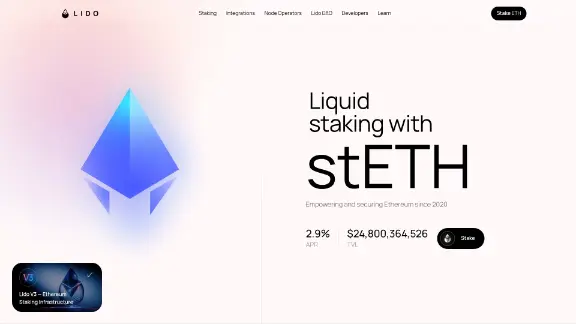Wrapped stETH (WSTETH)
Wrapped stETH (WSTETH) is a token that provides a stable representation of staked Ether (stETH) without the rebasing mechanism, making it suitable for various decentralized finance (DeFi) applications. Developed by Lido, a liquid staking platform, WSTETH is designed to maintain a constant balance, unlike stETH, which undergoes regular rebasing.
Overview
Lido launched the WSTETH token on February 19, 2021, to enhance the usability of stETH in specific DeFi environments. While stETH adjusts daily to reflect staking rewards, WSTETH maintains a static balance, making it ideal for protocols requiring constant token balances, such as Uniswap and MakerDAO. WSTETH represents a share of the total stETH supply but does not undergo daily balance adjustments. Its value appreciates relative to stETH as staking rewards accumulate, allowing users to benefit from staking rewards while engaging in DeFi activities.

| Ticker | WSTETH |
| Category | Crypto-Backed Tokens |
| Website | https://lido.fi/ |
| @LidoFinance | |
| Telegram | lidofinance |
| https://www.reddit.com/r/LidoFinance/ | |
| Contract Addresses | |
|---|---|
| ethereum | 0x7f...a0 Copied! Copied! |
Functionality and use cases
WSTETH can be obtained by wrapping stETH through the Lido platform or via decentralized exchanges (DEXs) integrated with Lido. Once acquired, WSTETH can be used across multiple DeFi protocols on various blockchains, including Ethereum, Arbitrum, and Optimism. It serves as collateral in lending platforms like Aave and can be used in liquidity pools on exchanges such as Uniswap and Balancer. The static balance of WSTETH ensures smooth integration with protocols not designed to handle fluctuating balances, facilitating participation in yield farming and liquidity provision.
Bridging and cross-chain integrations
To enhance accessibility, Lido has extended WSTETH's availability across multiple blockchain networks. Support for bridging WSTETH to Arbitrum and Optimism was introduced on October 6, 2022, followed by a bridge to the Cosmos ecosystem via Neutron on September 28, 2023. Further deployments have occurred on networks such as BNB Smart Chain, Avalanche, Scroll, Mantle, Linea, and zkSync. These capabilities allow WSTETH to be used across various blockchain ecosystems, enhancing its utility within the DeFi landscape.
Lido Finance
Lido is a decentralized staking solution that facilitates the staking of assets on blockchain networks like Ethereum and Polygon. Unlike traditional staking methods that often require assets to be locked up, Lido allows users to maintain liquidity. When users stake through Lido, they receive liquid staking tokens like stETH, corresponding to their staked assets. These tokens accrue staking rewards and can be utilized in various decentralized finance (DeFi) applications, offering both liquidity and the ability to participate in other on-chain activities. Lido operates by pooling user deposits and staking them with network validators, aiming to simplify the staking process while enabling continuous reward generation and asset flexibility.
